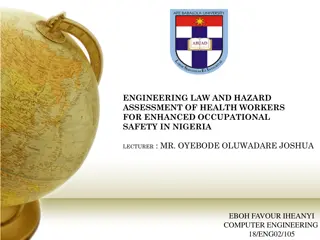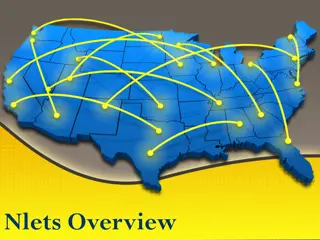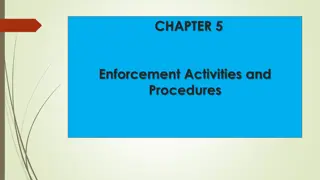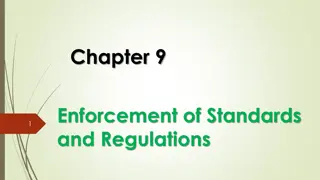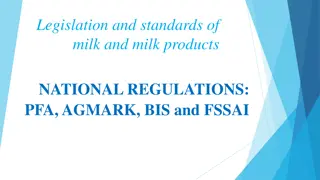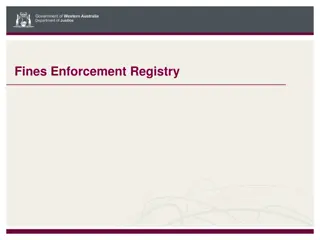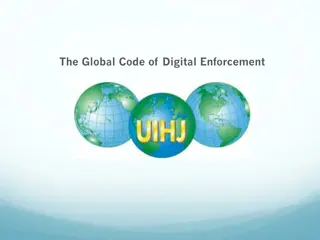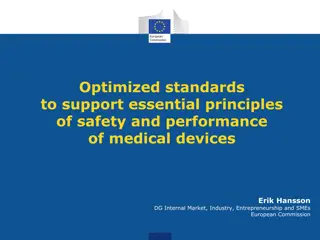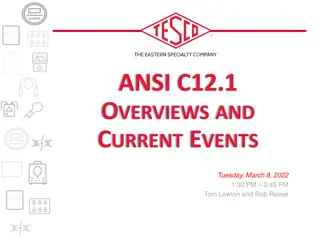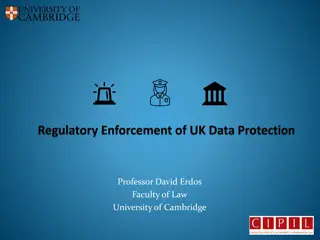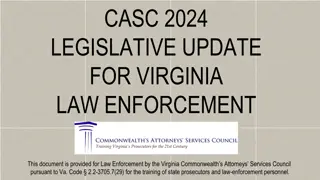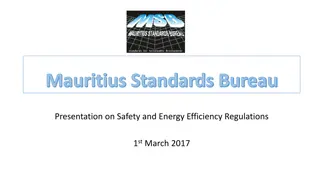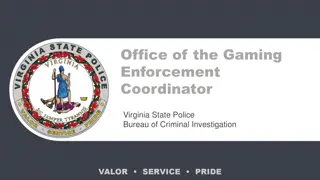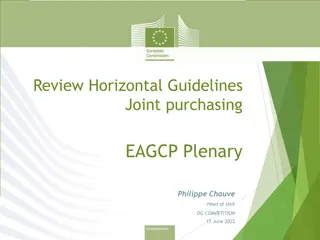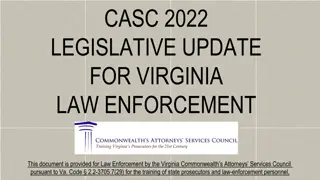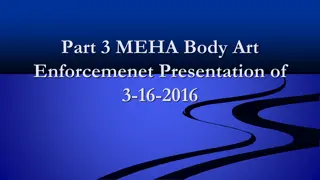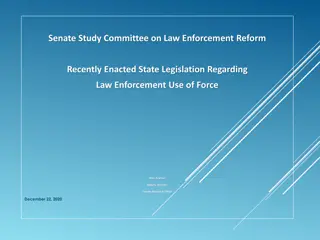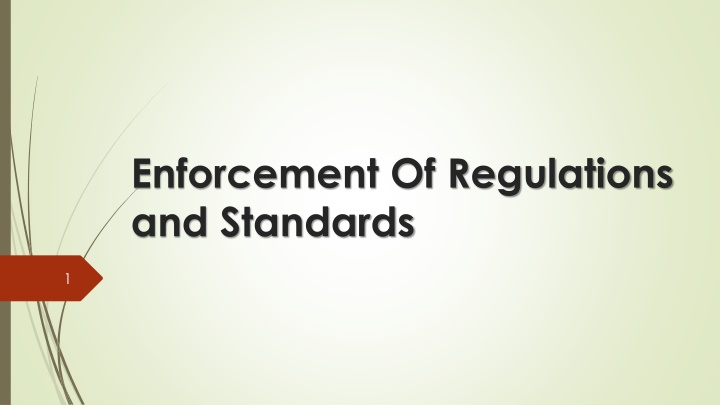
Oversight and Compliance: Ensuring Aviation Safety
This document outlines the importance of enforcement policies in ensuring compliance with aviation safety regulations. It covers the objectives of enforcement, definitions of key terms, and the role of the Civil Aviation Authority (CAA) in promoting safety. The enforcement policy aims to regulate the industry equitably, transparently, and consistently to enhance safety standards.
Download Presentation

Please find below an Image/Link to download the presentation.
The content on the website is provided AS IS for your information and personal use only. It may not be sold, licensed, or shared on other websites without obtaining consent from the author. If you encounter any issues during the download, it is possible that the publisher has removed the file from their server.
You are allowed to download the files provided on this website for personal or commercial use, subject to the condition that they are used lawfully. All files are the property of their respective owners.
The content on the website is provided AS IS for your information and personal use only. It may not be sold, licensed, or shared on other websites without obtaining consent from the author.
E N D
Presentation Transcript
Enforcement Of Regulations and Standards 1
Objectives 2 Review the Enforcement Policy and Procedures Carry out Enforcement investigation Determine Enforcement action
3 Chapter Content Enforcement Policy and Procedures Enforcement Investigation Enforcement Actions Enforcement Process
Definitions of terms 4 Violation a deliberate action known to be against the rules, to break a rule or be in breach of, synonyms: infringement, contravention. Compliance shall mean all applicable Regulations, Directives, Safety Standards and Associated Procedures being met or adhered to, as applicable. Compliance can only be in accordance with Regulations, associated supplementary documents, documented procedures and documented safety standards. When compliance exists, there is no need for enforcement. Enforcement - is the action taken when there is evidence of violation and lack of compliance with the applicable law. Enforcement requires legal or administrative action
Importance of Enforcement in the resolution of safety concerns 5 The CAA s enforcement policy plays a vital role in the discharge of its responsibility for safety oversight of the operators/service providers and promotes the goal of improved aviation safety by encouraging voluntary compliance with the provisions of the primary law and Civil Aviation Regulations
CAA Enforcement policy 6 Promotes compliance with aviation safety regulations through enforcement functions in an equitable, fair and transparent manner to achieve trust and confidence from the aviation industry and the members of the public. The enforcement policy plays a vital role in the discharge of the CAA responsibility for oversight of operator/service providers and promotes the goal of improved aviation safety. Ensures that the decisions or decision making processes are effective, fair, timely, consistent, properly documented in accordance with the dictates of the regulations.
CAA Enforcement policy Cont.. Determines the way it uses its powers to regulate the aviation industry. Ensure that it gives proper focus to the exercise of its powers and put adequate measures in place to give effect to the rule of law. consistent and systematic enforcement process would enhance the confidence level of compliant operator/service providers. Gathers and maintains systematic record of an operator's compliance or lack of it with applicable regulations and approved procedures 7
The Structure of CAA Enforcement Policy 8 The Policy consists of: Introduction Obligation Voluntary compliance Principles of enforcement Policy Conflict of Interest Proportionality of Responses Natural Justice and Accountability Exceptions
Principles of the enforcement Policy 9 The policy outlines a range of enforcement options intended to effectively secure compliance with primary law and regulations depending on the circumstances. These options include: Oral counselling; Letter of correction; Warning Letter; Issuance of aviation infringement notices
10 Types of Enforcement Action Enforcement action may include: Requiring license, certificate or authorization holders to undergo remedial training and be re tested; or examined; Taking administrative action to vary, suspend or cancel a licence, certificate or authorization. Referring the matter to the Director of Public Prosecutions
11 What influences enforcement decisions Enforcement decisions must not be influenced by: personal conflict; personal gain; considerations such as gender, race, religion, political views or affiliation; or personal, political or financial power of those involved.
Natural Justice and Accountability 12 Enforcement decisions must: be fair and follow due process; be transparent to those involved; take into account the circumstances of the case, the attitude-and or actions of the service provider or individual when considering action; be consistent in actions or decisions for similar circumstances; and be subject to appropriate internal and external review.
Enforcement procedures 13 Enforcement procedures involves the following actions; Completing the violation reporting form Carrying out enforcement investigation Determining enforcement action
Enforcement Investigation 14 CAA inspector s role in an investigation is to gather all material, relevant evidence that either proves or disproves violation. Detection is the discovery of a possible violation of the civil aviation regulations. Sources of detection are diverse and may result from activities such as inspections, audits, and surveillance programs, including police reports and public complaints. Priority shall be given to alleged violations that are believed to have a direct impact on safety.
Types of violation 15 Disregard of procedures a situation where a service provider did not apply or comply with regulatory requirements or procedures resulting in an occurrence. Carelessness deviation from standard operating procedures. E.g., not updating the equipment status during shift handover where such a deviation is found to be potentially dangerous.
Types of violation Cont.. 16 Negligence a situation where an ANSP returns an unsafe facility to use for air navigation after being informed that the condition is detrimental to aircraft operations. Recklessness when an ANSP performs a deliberate act to put air navigation operations, facilities and consequently a flight in danger, or deliberately ignores an obvious risk.
Planning and Coordinating the Investigation 17 It involves: Planning the investigation Assigning an Enforcement Investigative Report (EIR) number Coordination with supporting offices; Communications with Legal Department Timeliness goals.
Principle of Applying Investigative Findings 18 Enforceable regulations Elements of regulations Burden and standard of proof Relevance and materiality
Letter of Investigation (LOI) 19 Describes facts and circumstances which necessitate the investigation in sufficient detail in order to identify the alleged violation Specifies an appropriate time limit for reply, normally not to exceed a specified timeframe. Requests that specific documents be retained or made available for inspection and copying.
Methods of Sending the LOI 20 Certified mail/regular mail to the current address on record, so as to establish a record of notice to the certificate holder under investigation. Email Courier services
Enforcement Investigative Report 21 The Enforcement Investigative Report (EIR) is the means for documenting, assembling, organizing, and presenting all evidence and other relevant information obtained during an investigation It is the record from which determinations of violations and sanctions are made.
Enforcement Actions 22 Enforcement focuses the CAA s efforts on those violations that have the greatest safety impact. The highest priorities among enforcement cases are emergency actions, and generally those that involve certificate holder qualifications.
Selection of Enforcement Action The seriousness of the safety-related implications of the instance of non-compliance under scrutiny; Mitigating or aggravating circumstances impacting on the appropriateness of the responsive regulatory action(s) contemplated; History and background of the person whose acts or omissions are under scrutiny, in relation to that person s demonstrated ability and willingness to co-operate with CAA in the efforts to address the particular matter at hand, address relevant safety-related issues generally, and comply with regulatory requirements; Passage of time since the acts or omissions under scrutiny occurred, and when they were discovered by or otherwise came to the attention of CAA; 23
Selection of Enforcement Action Cont.. 24 Degree of responsibility of the individual(s) whose acts or omissions are under scrutiny; The kind(s) of action that will effectively and efficiently address the safety issues that have arisen, or are likely to arise, in the particular circumstances; The effect on the wider aviation community (including the general public) and confidence in CAA s administration of the civil aviation legislation in the interests of safety; Obsolescence or obscurity of the law;
Selection of Enforcement Action Cont.. 25 Whether the contemplated regulatory response would be perceived as counter-productive, for example, by bringing the civil aviation legislation or CAA into disrepute; Availability and efficacy of appropriate alternatives to a particular regulatory response; Whether the consequences of the regulatory action contemplated would be unduly harsh or oppressive; Whether the matter is one of considerable public concern; The actual or potential harm occasioned to an individual or the damage to property; The nature and sufficiency of the evidence of non-compliance that is available which may be obtained through information received from industry, from surveillance, an initial or further operational/technical investigation.
Enforcement Options 26 There are two enforcement options available to the ANS Inspector as a result of findings following an audit or inspection of an ANSP. These options are: Administrative action / Non-legal: oral or written counseling, warning notices, letters of correction, written notification of corrective action required, remedial training and re- examination personnel, or re-inspection of facilities and equipment, voluntary surrender of certificate. Legal action: civil penalty, suspension or revocation of certificate, injunctions, cease and desist orders, certificate denials and seizure of equipment
Administrative Action 27 The purpose of administrative enforcement action is to provide a means for disposing of violations which in the judgment of the CAA s inspectors do not require use of legal enforcement action. It should not to be taken solely as a matter of convenience or where evidence to support a finding of violation is lacking. Administrative actions are not adjudications and are intended to bring the violation to the attention of the certificate holder, document corrective action, encourage future compliance with the regulations and provide a source of information for the CAA s use. Administrative action may be taken in lieu of legal action only when all of the following elements are present:
Administrative Action Cont... 28 No significant unsafe condition existed. Legal enforcement action is not required by law. Lack of competency or qualification was not involved. The violation was inadvertent, that is it was not deliberate. The violation was not a substantial disregard for safety. The alleged violator has a constructive attitude toward complying with the regulations and has not been involved in previous similar violations.
Types of administrative enforcement action 29 Warning Notice: A letter addressed to the alleged violator (an individual) and it has an EIR number for traceability. The letter: States the facts and circumstances of the incident involved, Advises that on the basis of available information, such operations or practices appear to be contrary to the regulations, States that the matter HAS BEEN CORRECTED and/or does not warrant legal enforcement action, and Advises that future compliance with the regulations will be expected.
Types of administrative enforcement action 30 Letter of Correction: The Letter serves the same purposes as the warning letter, but is intended for use when there is agreement with the certificate holder (an organization) that corrective action acceptable to the CAA will be taken within reasonable time. The letter has an EIR number for traceability. States the facts and circumstances of the incident involved.
Letter of Correction cont.. 31 The Letter of Correction will usually confirm a discussion with the certificate holder in which a violation is acknowledged and appropriate corrective action initiated. The Letter of Correction should not be used solely to forward suggestions and recommendations but for the purpose of correcting a bona-fide non-compliance item. When corrective action has not been completed at the time the letter of correction is issued, the CAA inspector must ensure that timely follow-up inspection is performed. A discrepancy close-out letter must be issued when deficiencies found during the inspection have been corrected.
Legal Action 32 Appropriate legal action must be taken in cases which do not meet all of the criteria for administrative action. Formal legal action is undertaken to 1) Prevent future actions which would violate the regulations (e.g. cease and desist orders, injunctions); 2) Impose punitive sanctions, after the act, to deter violations (e.g. certificate actions, civil penalties).
Legal Action Cont.. 33 In determining the appropriate type and measure of sanction to be applied, the following factors shall be taken into account, as applicable: - The nature of the violation and whether deliberate or inadvertent. The potential or actual hazard to the safety of others created by the violation. The certificate holder's level of experience and responsibility. The violator's history of previous violations. The violator's attitude regarding the violation, including whether the violator voluntarily disclosed the violation, and actions taken to correct it. The impact of a proposed sanction on the violator and its value as a deterrent to others similarly situated.
Types of legal enforcement action 34 There are two types of legal enforcement action: 1) Civil Penalty Action &: 2) Certificate Action A civil penalty is a payment of money. This is normally applied where there designated sanctions as provided for in the primary act or regulations and the qualification of the certificate holder is not in question. It is also the preferred option where normal operations of the certificate holder should not be adversely affected.
Types of legal enforcement action 35 Certificate Action: There are two types of certificate action that can be considered. Certificate suspension Certificate revocation
Certificate Suspension 36 A suspension of a certificate means the certificate temporarily ceases to be effective. The time the certificate is not effective is specified in the order of suspension, and once the required time period has passed, the certificate is automatically reinstated. The time period is defined by either a specific amount of time, usually a number of days or until certain conditions are met. The CAA may amend, modify, suspend or revoke any part of a certificate.
Certificate Suspension Cont.. 37 Certificate suspension can be considered when: - Operational safety requires it and all other means for timely correction of an unsafe condition, or assuring safe aircraft operations, cannot be achieved. Technical proficiency or qualifications of the certificate holder to perform the duties required by are inadequate. The certificate holder resists or is unwilling to take action to correct or mitigate a non-complying condition which directly affects the safe operation of aircraft operation, or The certificate holder willfully fails to perform the corrective action agreed upon and punitive action is the last alternative available to the Inspector.
Certificate Revocation/ Cancellation 38 A revocation of a certificate means the certificate is no longer valid, and the holder may not exercise any of its privileges. Unlike a suspension, a certificate that has been revoked cannot be reinstated. An ANSP whose certificate has been revoked may re-apply for a new certificate, but an individual applying for a certificate must meet all the qualifications for the new certificate, including retaking all tests, whether written, oral, or practical. Any experience requirements for the new certificate may be met with experience obtained before the revocation of the original certificate. Specific regulations empower the Authority and state conditions for certificate revocation.
Certificate Revocation/ Cancellation Cont.. Certificate revocation can be considered when: - The certificate holder is incapable of corrective action and has demonstrated by repeated offences and unwillingness or inability to comply with vital safety provisions of the regulation, and that continued possession of the certificate would be detrimental to the public interest. The certificate holder has clearly demonstrated a lack of responsibility, such as deliberate and flagrant acts of non-compliance, or falsifying record 39
Emergency Suspension of Certificate 40 Emergency action is to be taken only when it is clearly needed in the public interest and must be taken immediately when such action is recognized. Emergency action will not be used for punitive reasons
Termination of a Suspension of an ANSP certificate 41 If the ANSP satisfactorily corrects the violation(s) for which the suspension was issued, the Authority shall issue a letter advising of that finding with a copy to the Legal Department (LD). The LD will then take appropriate steps to terminate the suspension order. No action to suspend, revoke or terminate a suspension of an ANS certificate, or to initiate legal action, will be taken without the prior approval of the head of oversight. It is important to note that an investigation should be completed well within a specified timeframe
Enforcement Process 42 Identification of the alleged violated statutory and regulatory provision, determines enforceability and applicability; Preparation of a risk statement, classifies the violation according to level of seriousness and safety threat it may pose or cause; Administration of oral counseling in a case where the violation possesses minimum - low safety risk; Issuance of a detection notice/ infringement notice and seizes evidence in all other cases;
The Enforcement Process 43 planning and coordination of the investigation, where the violation had not exceeded a statutory time limit or related to criminal activity; (No investigation) Proving of the existence of a violation through acquired evidence; determining the appropriate enforcement action using the EDT, recommends type of sanction; and supporting the LD through the head of inspectorate for legal action for cases that did and can jeopardize safety.
SUMMARY 44 We have covered: Review of the Enforcement Policy and Procedures Carrying out of Enforcement investigation Determination of Enforcement action
End of Chapter Thank You 45



